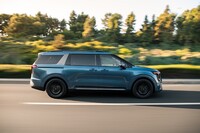Remember when minivans were as popular as crossovers and SUVs have become?
A better question might be: Why have crossovers and SUVs become so much more popular than minivans are now? The latter are objectively better in terms of practicality and utility, the two main reasons most people buy crossovers and SUVs. But minivans are roomier — and the room is much easier to use because of features such as sliding side doors.
So, why?
Probably because minivans have an image problem. They are seen by many as boring; the family-mobile you have to get while wishing you could have gotten something else. Crossovers and SUVs are seen as less boring — and that's probably why so many prefer to be seen in them.
Even though they are less practical.
So, what to do — if you're trying to sell a new minivan?
Well, you can make it look less like a minivan. And you can try to make it more fun.
That's what Kia has tried to do with its minivan, which is literally named after a carnival.
What It Is
The Carnival is Kia's minivan — and one of just a small handful of new minivans still on the market, including the Toyota Sienna, Honda Odyssey and the Chrysler Pacifica (the latter is Chrysler's sole remaining model and getting long in the tooth; the current model dates back to 2017, so it's almost a six-year-old design).
It differs from the others in that Kia tried hard to make the Carnival look more like an SUV than a minivan, without losing the practicality you get with a minivan (especially the sliding side doors). It also comes standard with a V6 engine, bucking the trend of going with a small four-cylinder/hybrid-augmented drivetrain (as in the Sienna).
The Carnival is also — by far — the most affordable new minivan on the market.
Prices start at $36,990 for the base LX trim, which comes with second-row captain's chairs and seven-passenger capacity — plus a 3.5-liter, 287-horsepower V6 engine. This trim also comes with hands-free power sliding doors (just push a button), three-zone climate control and a six-speaker audio system.
As a point of comparison, the 2025 Chrysler Pacifica — which also comes standard with a V6 — starts at $42,450. A 2025 Toyota Sienna stickers for $39,895 to start. That's about $3,000 more than the Carnival's base price — negating much of the Toyota hybrid's gas mileage advantage.
The Honda Odyssey still comes standard with a V6, but it stickers for $41,920 to start.
The Carnival is also available in LXS ($38,990), EX ($41,190), SX ($46,090) and top-of-the-line SX Prestige ($51,090) trims. The SX Prestige can be ordered with a pair of second-row VIP Lounge seats and comes standard with a 12-speaker Bose sound system as well as all the amenities that are standard in the lower trims, including power folding exterior mirrors, voice controls for many secondary functions, a dual-panel panorama sunroof, LED interior lighting and upgraded LED headlights.
Kia also offers a hybrid version of the Carnival — new for 2025. It stickers for $40,800 to start and tops out at $52,900 for the SX Prestige trim.
What's New for 2026
In addition to the new hybrid variant, the larger (12-inch) LCD touch screen that was previously optional is now standard — along with Apple CarPlay and Android Auto.
What's Good
— The least expensive and arguably most interesting minivan on the market right now.
— Comes standard with a V6 — but you can get a hybrid drivetrain, if you like.
— Much more room inside than you'll find inside rival vans such as the Toyota Sienna.
What's Not So Good
— Not available with all-wheel drive (the Toyota Sienna and Chrysler Pacifica both offer it).
— SUV-like gas mileage (18 mpg city, 25 mpg highway).
— Wonderful lounge seats are restricted to the $50,000-plus SX Prestige — and if you want the optional dual-screen (14.6-inch) backseat entertainment system, it'll cost you another $2,500.
Under the Hood
Every Carnival comes standard with a 3.5-liter, 287-horsepower V6 engine paired with an eight-speed automatic transmission and front-wheel drive.
It's interesting that this minivan has a bigger engine than most crossovers and also some SUVs — many of which now have small four-cylinder engines augmented by a turbocharger or a partially electric (hybrid) drivetrain.
It's true the Carnivals' gas mileage — 18 mpg city, 25 mpg highway — isn't spectacular. More finely, it is not as good as hybrid-augmented/four-cylinder-powered minivans such as the Toyota Sienna. The latter touts 36 mpg — in both city and highway driving. But you have to pay about $3,000 more to "save" on gas, and it's going to take a lot of years and miles to reach the point at which the hybrid actually does save you money overall.
Another Carnival rival — the Chrysler Pacifica — also comes standard with a V6, but it costs $5,460 more to start, so you won't be saving money there, either. The Pacifica's 3.6-liter V6 also makes exactly the same 287 horsepower as the Carnival's.
The Kia's main weakness relative to its main rivals — which offer AWD — is that AWD is not available with the Carnival. But this is a weakness only if you are wanting AWD — which is only functionally relevant if you live in an area where it snows a lot. In warmer parts of the country, having an AWD-equipped vehicle is kind of like having a nice winter coat in the closet.
Regardless of trim, every Carnival is rated to pull up to 3,500 pounds.
On the Road
This minivan is as quick as most of the V8 muscle cars of the '70s were.
It can get to 60 mph in just shy of seven seconds, and it can even squeal the tires too (because it's not AWD). If you floor it from a dead stop, you'll get a little of that, which is kind of fun — like a carnival. It's a form of busting loose, both literally and psychologically. Most new vehicles are arguably too controlled, too parental. This takes away from the fun, even if the thing accelerates more quickly than a V8 muscle car.
It's quite something that this minivan is more open to shenanigans than many "sport" sedans.
Another nice aspect — relative to crossovers (and, even more so, SUVs) is that it's easier to get into and out of because it's not as high off the ground. You just open the door and sit down. You do not have to climb aboard, first. Because this is a minivan, it has excellent all-around visibility — particularly the view to the side — because of the large sheets of glass on either side. Being able to see clearly — especially to the side — is something that's no longer standard in most new vehicles due to the I-beam thick "B" and "C" pillars that are used to support the roof as well as the vehicle, in the event it rolls over (per federal requirements). In a crossover or an SUV, there is less glass area on the sides of the vehicle due to the nature of the design, so seeing is harder, which can make for a dark carnival in the event you don't see something and inadvertently pull out in front of it.
At the Curb
Minivans offer unparalleled space efficiency — for both people and stuff. Not just the space, either. A full-size SUV — something like a Chevy Tahoe, for instance — also has a lot space for passengers and cargo. But its space is less efficient because it is much harder to use. An SUV's third row, for instance, is awkward to get into and out of because you have to work your way past the second row via a much smaller door opening. In a minivan, you have these enormous sliding doors that, when open, open up most of the inside, making access so much easier. The step-in height is much lower too — further easing entry/exit (and easing loading/unloading of stuff too).
But here's the really impressive part. Even though the Tahoe is nearly a foot longer (and much taller) than this minivan, it has a lot less space inside — in addition to being less space efficient. It has 25.5 cubic feet of cargo space behind its third row and — when its third and second row seats are folded out of the way — it has 122.7 cubic feet of total cargo-carrying space.
The Carnival — which is 203 inches long versus 211.3 inches for the Tahoe — has 40.2 cubic feet of space with its seats in place, and if you fold the second and third rows down, the space available opens up to 145.1 cubic feet.
But space aside, there is something else none of the Kia's rivals even offer: a different look. The other minivans look like minivans. The Carnival looks less like one, especially when its dual sliding doors are closed. It looks more like a low-riding SUV, and that may appeal to you if you don't especially like the looks of a minivan — or the looks you get when you drive one.
The Rest
The available Lounge seats are wonderful — if you can afford them. So equipped, the Carnival is for adults rather than kids. Rear-seaters can recline as if at home — a very nice home, with those dual-flatscreen monitors playing a movie. When I tested a Carnival so equipped, we spent an evening in the driveway — because it was nicer in the Carnival than in my living room. But this experience is only available to those with the means to enjoy it, which is a shame. Kia might sell more Carnivals if it offered the Lounge seats and dual flatscreens as an optional package available with the more affordable trims.
The Bottom Line
Whoever said a minivan couldn't be practical — and fun — has never experienced the Carnival.
Eric's latest book, "Doomed: Good Cars Gone Wrong!" will be available soon. To find out more about Eric and read his past columns, please visit the Creators Syndicate webpage at www.creators.com.
View the Kia Carnival this week.







View Comments